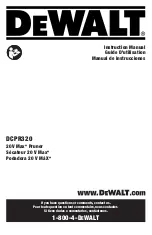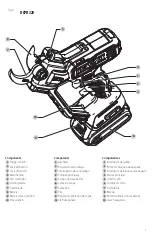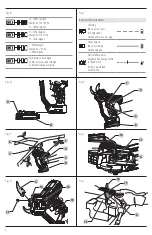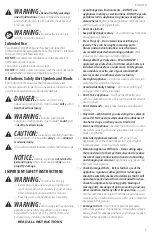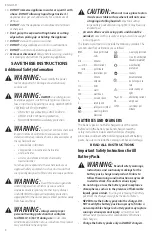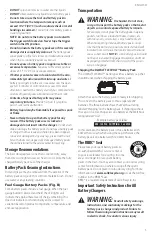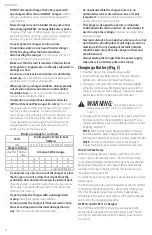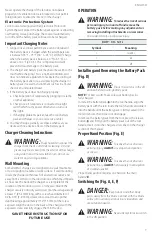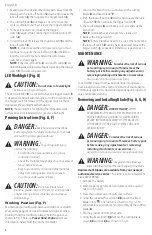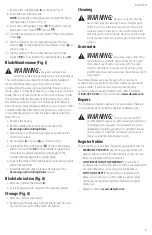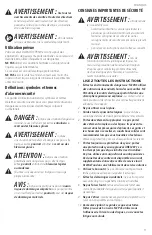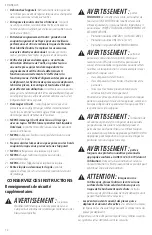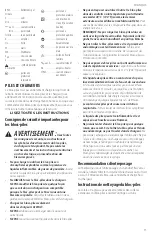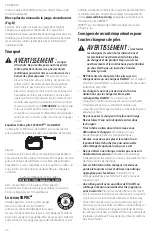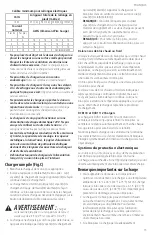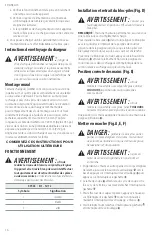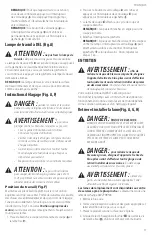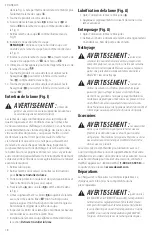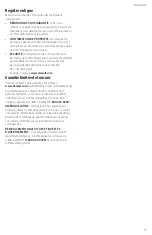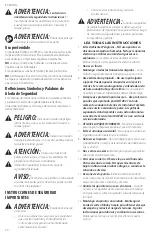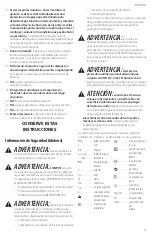
English
6
•
Do not disassemble the charger; take it to an
authorized service center when service or repair
is required.
Incorrect reassembly may result in a risk of
electric shock, electrocution or fire.
•
The charger is designed to operate on standard
120V household electrical power. Do not attempt to
use it on any other voltage.
This does not apply to the
vehicular charger.
•
Foreign materials of a conductive nature, such as, but
not limited to, grinding dust, metal chips, steel wool,
aluminum foil or any buildup of metallic particles
should be kept away from the charger cavities and
ventilation slots.
•
Always unplug the charger from the power supply
when there is no battery pack in the cavity.
Charging a Battery (Fig. C)
1. Plug the charger into an appropriate outlet.
2. Insert and fully seat battery pack. The red charging
light(s) will continuously blink while charging.
3. Charging is complete when the red charging light(s)
remain(s) continuously ON. Battery pack can be left in
charger or removed. Some chargers require the battery
pack release button to be pressed for removal.
WARNING:
Only charge batteries in air
temperature over 40 ° F (4.5 ° C) and below 104 ° F
(+40 ° C).
4. Charger will not charge a faulty battery pack, which may
be indicated by the charging light(s) staying OFF. Take
charger and battery pack to an authorized service center
if light(s) stay(s) OFF.
nOTE:
Refer to label near charging light(s) on charger
for blink patterns. Older chargers may have additional
information and/or may not have a yellow indicator light.
nOTE:
To remove the battery pack, some chargers
require the battery pack release button to be pressed.
hot/Cold Pack Delay
When the charger detects a battery pack that is too hot
or too cold, it automatically starts a Hot/Cold Pack Delay,
suspending charging until the battery pack has reached an
appropriate temperature. The charger then automatically
switches to the pack charging mode. This feature ensures
maximum battery pack life.
A cold battery pack may charge at a slower rate than a warm
battery pack.
The hot/cold pack delay will be indicated by the red light(s)
continuing to blink but with the yellow light continuously
ON. Once the battery pack has reached an appropriate
temperature, the yellow light will turn OFF and the charger
will resume the charging procedure.
DCB118 and DCB1112 Chargers
The DCB118 and DCB1112 chargers are equipped with
an internal fan designed to cool the battery pack. The fan
will turn on automatically when the battery pack needs to
be cooled.
•
DO NOT attempt to charge the battery pack with
any chargers other than a
D
e
WALT
charger.
D
e
WALT
chargers and battery packs are specifically designed to
work together.
•
These chargers are not intended for any uses other
than charging
D
e
WALT
rechargeable battery packs.
Charging other types of battery packs may cause them to
overheat and burst, resulting in personal injury, property
damage, fire, electric shock or electrocution.
•
Do not expose the charger to rain or snow.
•
Do not allow water or any liquid to enter charger.
•
Pull by the plug rather than the cord when
disconnecting the charger.
This will reduce the risk of
damage to the electric plug and cord.
•
Make sure that the cord is located so that it will not
be stepped on, tripped over or otherwise subjected to
damage or stress.
•
Do not use an extension cord unless it is absolutely
necessary.
Use of improper extension cord could result in
risk of fire, electric shock or electrocution.
•
When operating a charger outdoors, always provide
a dry location and use an extension cord suitable
for outdoor use.
Use of a cord suitable for outdoor use
reduces the risk of electric shock.
•
An extension cord must have adequate wire size
(AWG or American Wire Gauge) for safety.
The smaller
the gauge number of the wire, the heavier the cord and
thus the greater its capacity. An undersized cord will
cause a drop in line voltage resulting in loss of power and
overheating. The following table shows the correct size
to use depending on total length of all extension cords
plugged together, and nameplate ampere rating. If in
doubt, use the next heavier gauge.
Minimum gauge for Cord sets
Volts
Total length of Cord in Feet
(meters)
120V
25 (7.6)
50 (15.2) 100 (30.5) 150 (45.7)
Ampere Rating
American Wire gauge
More Than Not More
Than
0
6
18
16
16
14
6
10
18
16
14
12
10
12
16
16
14
12
12
16
14
12
Not Recommended
•
Do not place any object on top of the charger or place
the charger on a soft surface that might block the
ventilation slots and result in excessive internal heat.
Place the charger in a position away from any heat source.
The charger is ventilated through slots in the top and the
bottom of the housing.
•
Do not operate the charger with a damaged cord
or plug.
Have them replaced immediately.
•
Do not operate the charger if it has received a sharp
blow, been dropped or otherwise damaged in any
way.
Take it to an authorized service center.
Содержание DCPR320
Страница 31: ......

